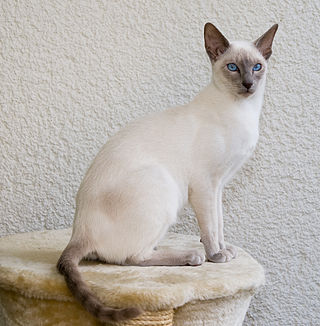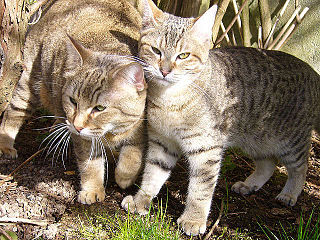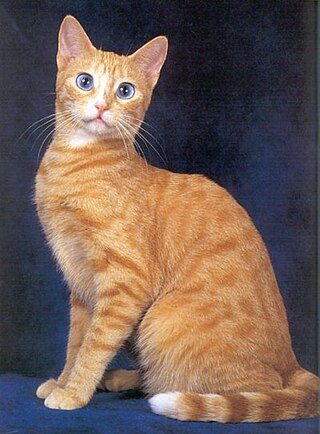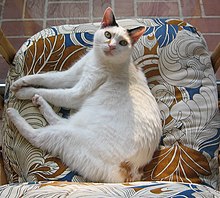
The Siamese cat is one of the first distinctly recognised breeds of Asian cat. Derived from the Wichianmat landrace, one of several varieties of cats native to Thailand, the original Siamese became one of the most popular breeds in Europe and North America in the 19th century. Siamese cats have a distinctive colourpoint coat, resulting from a temperature-sensitive type of albinism.

The Cornish Rex is a breed of domestic cat. The Cornish Rex has no hair except for down hair. Most breeds of cat have three different types of hair in their coats: the outer fur or "guard hairs", a middle layer called the "awn hair"; and the down hair or undercoat, which is very fine and about 1 cm long. Cornish Rexes only have the undercoat. Occasional individuals are prone to hair loss or will develop a very thin coat or even go bald over large parts of their body. The curl in their fur is caused by a different mutation and gene than that of the Devon Rex. The breed originated in Cornwall, Great Britain.

The Sphynx cat also known as the Canadian Sphynx, is a breed of cat known for its lack of fur. Hairlessness in cats is a naturally occurring genetic mutation, and the Sphynx was developed through selective breeding of these animals, starting in the 1960s.

The Turkish Van is a semi-long-haired, standardised breed of domestic cat, which was developed in the United Kingdom from a selection of cats obtained from various cities of modern Turkey, especially southeast Turkey. The breed is rare, is one of the larger breeds, and is distinguished by the Van pattern, where the colour is restricted to the head and the tail, and the rest of the cat is white; this is due to the expression of the piebald white spotting gene, a type of partial leucism. A Turkish Van may have blue or amber eyes, or be odd-eyed.

The Maine Coon is a large domesticated cat breed. One of the oldest natural breeds in North America, the breed originated in the U.S. state of Maine, where it is the official state cat.

The Russian Blue cat, commonly referred to as just Russian Blue, is a cat breed with colors that vary from a light shimmering silver to a darker, slate grey. The short, dense coat, which stands out from the body, has been the breed's hallmark for more than a century.

The Manx cat is a breed of domestic cat originating on the Isle of Man, with a mutation that shortens the tail. Many Manx have a small stub of a tail, but Manx cats are best known as being entirely tailless; this is the most distinguishing characteristic of the breed, along with elongated hind legs and a rounded head. Manx cats come in all coat colours and patterns, though all-white specimens are rare, and the coat range of the original stock was more limited. Long-haired variants are sometimes considered a separate breed, the Cymric.

The Cymric is a Canadian cat breed. Some cat registries consider the Cymric a semi-long-haired variety of the Manx breed, rather than a separate breed. Except for the length of fur, in all other respects, the two varieties are the same, and kittens of either sort may appear in the same litter. The name comes from Cymru, the indigenous Welsh name of Wales, even though the breed is not associated with Wales. The name may have been chosen to provide a "Celtic" sounding moniker for the breed. While the breed's Manx bloodline originated from the Isle of Man, the long-haired variant is claimed to have been developed by Canada. The breed is called the Longhair Manx or a similar name by some registries.

The Scottish Fold is a distinctive breed of domestic cat characterised by a natural dominant gene mutation associated with osteochondrodysplasia. This genetic anomaly affects cartilage throughout the body, causing the ears to "fold", bending forward and down towards the front of the head. While this trait contributes to the breed's unique appearance, often described as "owl-like", it has negative effects on the cats' welfare.

The American Bobtail is an uncommon breed of domestic cat which was developed in the late 1960s. It is most notable for its stubby "bobbed" tail about one-third to one-half the length of a normal cat's tail. This is the result of a cat body type genetic mutation affecting the tail development, similar to that of a Manx cat. The breed is not related to other short-tailed breeds, such as the Cymric cat, or the Japanese Bobtail or Kurilian Bobtail, despite the similar name and physical type—the breeding programs are entirely unrelated, and the genetic mutation causing the bobbed tail are known to be different, as the mutation causing the American Bobtail's short tail is dominant; comparatively, the Japanese Bobtail, for example, has a tail mutation that is recessive.

The Havana Brown was the result of a planned breeding between Siamese and domestic black cats, by a group of cat fanciers in England, in the 1950s. Early breeders introduced a Siamese type Russian Blue into their breeding. However, using current genetic testing, it is believed that almost none remain in the gene pool.

The Ragdoll is a breed of cat with a distinct colorpoint coat and blue eyes. Its morphology is large and weighty, and it has a semi-long and silky soft coat. American breeder Ann Baker developed Ragdolls in the 1960s. They are best known for their docile, placid temperament and affectionate nature. The name Ragdoll is derived from the tendency of individuals from the original breeding stock to go limp and relaxed when picked up. The breed is particularly popular in both the United Kingdom and the United States.

The Pixie-bob is a breed of domestic cat claimed to be the progeny of naturally occurring bobcat hybrids. However, DNA testing has failed to detect bobcat marker genes, and Pixie-bobs are considered wholly domestic for the purposes of ownership, cat fancy registration, and import and export. They were, however, selected and bred to look like American bobcats.

Ojos Azules was a breed of shorthaired domestic cat with unusual blue or odd eyes caused by a dominant blue eye (DBE) genetic mutation. The breed came in all coat colors; however, only particolors, colorpoints, and intermediate colors with a characteristic white tail tip were permitted. The breed also had a semi-longhaired coat variety, the Ojos Azules Longhair. Due to the lethal side effects of the Ojos Azules gene, breeders stopped working with this blue eye mutation.
A natural bobtail is an animal's tail which due to a mutated gene grows unusually short or is missing completely. The genes for the shortened tail may be dominant or recessive.

An odd-eyed cat has one blue eye and one eye either green, yellow, amber, or brown. This is a feline form of complete heterochromia, a condition that occurs in some other animals, including humans. There is also sectoral (partial) heterochromia, where two different colours occur within the same iris. The condition most commonly affects solid white cats, but may be found in cats of any coat colour.

The Kurilian Bobtail is a cat breed originating from the Russian Kuril Islands, as well as Sakhalin Island and the Kamchatka peninsula of Russia. Short- or long-haired, it has a semi-cobby body type and a distinct short, fluffy tail. The back is slightly arched with hind legs longer than the front, similar to those of the Manx. The breed is also called the Kuril Islands Bobtail, Kuril Bobtail and Curilsk Bobtail, and may be referred to without "Bobtail". It is sometimes also spelled Kurilean. The original short-haired variant is a natural breed, known on the islands for over 200 years. As selectively bred pets, they have been popular in USSR and to some extent other parts of Europe, especially for their rodent-hunting abilities, since the middle of the 20th century, but remained rare in North America as of 2011.

The Balinese is a long-haired breed of domestic cat with Siamese-style point coloration and sapphire-blue eyes. The Balinese is also known as the purebred long-haired Siamese since it originated as a natural mutation of that breed and hence is essentially the same cat but with a medium-length silky coat and a distinctively plumed tail.





















